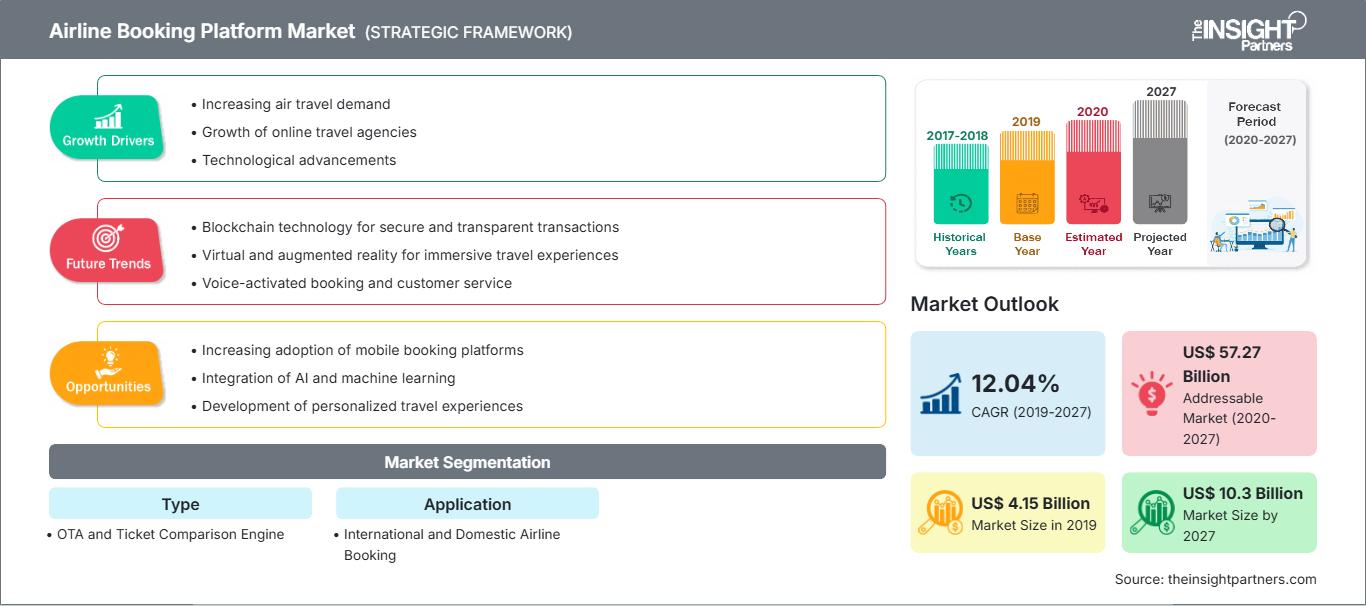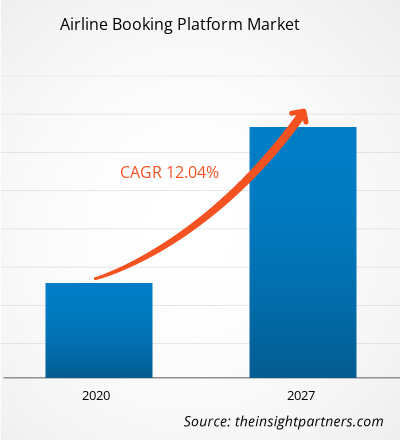Le marché des plateformes de réservation de billets d'avion était évalué à 4 150,65 millions de dollars américains en 2019 et devrait atteindre 10 303,88 millions de dollars américains d'ici 2027. Le marché des plateformes de réservation de billets d'avion devrait croître à un TCAC de 12,04 % au cours de la période de prévision de 2020 à 2027.
La demande croissante de voyages aériens a conduit plusieurs pays à constater une augmentation du nombre de plateformes de réservation de billets d'avion ces dernières années. Cette demande croissante a également forcé l'adoption de plateformes technologiquement avancées pour réserver divers services de voyage tels que la réservation de billets, la location de voitures, les réservations d'hôtel, et bien d'autres. La croissance soudaine du secteur de l'aviation commerciale est principalement attribuée à l'augmentation considérable du nombre de voyageurs aériens, tant pour les voyages d'affaires que pour les loisirs. De plus, les compagnies aériennes monétisent leurs services en améliorant leurs services supplémentaires. La croissance du nombre de voyageurs aériens est constatée depuis quelques années ; elle a un impact significatif sur le marché des plateformes de réservation de billets d'avion. L'augmentation du nombre de passagers aériens est la principale raison de la croissance du marché des plateformes de réservation. La diversité des économies des pays en développement, ainsi que l'augmentation du pouvoir d'achat des individus, ont un impact positif sur la croissance du marché. Depuis 15 ans, le nombre de passagers aériens a augmenté de 5 % par an à l'échelle mondiale. Selon l'Association du transport aérien international (IATA), ce nombre devrait doubler entre 2016 et 2035.
Le marché mondial des plateformes de réservation est segmenté selon le type de plateforme : OTA et comparateur de billets. Il est également segmenté selon l'application, entre réservations internationales et nationales. Le marché mondial des plateformes de réservation est classé géographiquement en Amérique du Nord, Europe, Asie-Pacifique (APAC), Moyen-Orient et Afrique (MEA) et Amérique du Sud (SAM).
Personnalisez ce rapport en fonction de vos besoins
Vous bénéficierez d’une personnalisation sur n’importe quel rapport - gratuitement - y compris des parties de ce rapport, ou une analyse au niveau du pays, un pack de données Excel, ainsi que de profiter d’offres exceptionnelles et de réductions pour les start-ups et les universités
Marché des plateformes de réservation de compagnies aériennes: Perspectives stratégiques

-
Obtenez les principales tendances clés du marché de ce rapport.Cet échantillon GRATUIT comprendra une analyse de données, allant des tendances du marché aux estimations et prévisions.
La transformation numérique est depuis des années l'un des axes majeurs de nombreuses organisations. Outre son efficacité marginale, le numérique bouleverse divers secteurs. De nombreux secteurs, dont les compagnies aériennes, exploitent les technologies numériques pour saisir de nouvelles opportunités commerciales. L'Association du transport aérien international (IATA) encourage les acteurs du secteur aérien à opérer la transformation numérique au sein de leurs activités, ce qui leur permet d'offrir une expérience client fluide tout en optimisant la sécurité et l'efficacité. Le secteur de l'aviation et du voyage est à l'avant-garde de la numérisation des opérations, transformant ainsi l'expérience de voyage. Les tendances technologiques s'unissent pour redéfinir les modèles économiques de l'écosystème de l'aviation et du voyage.
Analyse du marché par type
Le marché des plateformes de réservation aérienne a été segmenté selon le type : OTA et comparateur de voyages. Plusieurs agences de voyages et agents privés adoptent des outils technologiques de voyage avancés et innovants, tels que les applications mobiles, pour attirer et servir des clients à l'échelle mondiale. L'adoption continue de solutions de mobilité avancées et de technologies de voyage a conduit les agences à se concentrer sur les logiciels de réservation de billets en ligne, afin de faciliter la recherche et l'utilisation de toutes les offres en ligne pour les clients finaux et les agences partenaires. L'augmentation du trafic aérien à l'échelle mondiale est l'un des principaux moteurs de l'adoption des plateformes de réservation aérienne.
Analyse du marché basée sur les applications
Le marché des plateformes de réservation aérienne a été segmenté selon les applications : réservation de billets internationaux et nationaux. Actuellement, le marché des plateformes de réservation aérienne dans les pays en développement connaît une croissance rapide, grâce à la croissance du pouvoir d'achat des particuliers. Le segment de la réservation de billets nationaux gagne en importance, car les passagers sont de plus en plus enclins à consacrer leur temps libre à leurs loisirs, loin de leur emploi du temps chargé.
Marché des plateformes de réservation de compagnies aériennes
Les tendances régionales et les facteurs influençant le marché des plateformes de réservation aérienne tout au long de la période de prévision ont été analysés en détail par les analystes de The Insight Partners. Cette section aborde également les segments et la répartition géographique du marché des plateformes de réservation aérienne en Amérique du Nord, en Europe, en Asie-Pacifique, au Moyen-Orient et en Afrique, ainsi qu'en Amérique du Sud et en Amérique centrale.
Portée du rapport sur le marché des plateformes de réservation de compagnies aériennes| Attribut de rapport | Détails |
|---|---|
| Taille du marché en 2019 | US$ 4.15 Billion |
| Taille du marché par 2027 | US$ 10.3 Billion |
| TCAC mondial (2019 - 2027) | 12.04% |
| Données historiques | 2017-2018 |
| Période de prévision | 2020-2027 |
| Segments couverts |
By Type
|
| Régions et pays couverts |
Amérique du Nord
|
| Leaders du marché et profils d'entreprises clés |
|
Densité des acteurs du marché des plateformes de réservation de compagnies aériennes : comprendre son impact sur la dynamique commerciale
Le marché des plateformes de réservation de billets d'avion connaît une croissance rapide, portée par une demande croissante des utilisateurs finaux, due à des facteurs tels que l'évolution des préférences des consommateurs, les avancées technologiques et une meilleure connaissance des avantages du produit. Face à cette demande croissante, les entreprises élargissent leur offre, innovent pour répondre aux besoins des consommateurs et capitalisent sur les nouvelles tendances, ce qui alimente la croissance du marché.
- Obtenez le Marché des plateformes de réservation de compagnies aériennes Aperçu des principaux acteurs clés
Les acteurs opérant sur le marché des plateformes de réservation de compagnies aériennes se concentrent sur des stratégies, telles que des initiatives de marché, des acquisitions et des lancements de produits, pour maintenir leur position sur le marché des plateformes de réservation de compagnies aériennes. Voici quelques développements réalisés par les principaux acteurs du marché des plateformes de réservation de compagnies aériennes :
- En novembre 2019, KAYAK Software Corporation a lancé un service, « KAYAK for Business », destiné aux voyageurs d’affaires. Ce service permet de simplifier le processus de réservation de voyages d’affaires.
- En novembre 2019, Trip.com Group Limited s’est associé à TripAdvisor, Inc., une agence de voyages américaine. Ce partenariat stratégique permet à l’entreprise d’être leader sur le marché des capacités de réservation de voyages.
Marché des plateformes de réservation de compagnies aériennes – par type
- OTA
- Moteur de comparaison de billets
Marché des plateformes de réservation de compagnies aériennes – par type par application
- International
- Réservation de compagnies aériennes nationales
Plateforme de réservation de compagnies aériennes Marché – par géographie
- Amérique du Nord
- États-Unis
- Canada
- Mexique
- Europe
- France
- Allemagne
- Espagne
- Royaume-Uni
- Italie
- Russie
- Reste de l'Europe
- Asie-Pacifique (APAC)
- Chine
- Inde
- Japon
- Australie
- Corée du Sud
- Asie du Sud-Est
- Reste de l'APAC
- MEA
- Arabie saoudite
- ÉAU
- Sud Afrique
- Égypte
- Israël
- Turquie
- Reste du pays MEA
- SAM
- Brésil
- Reste de SAM
Marché des plateformes de réservation de compagnies aériennes – Profils d'entreprise
- Amadeus It Group Sa
- Blue Sky Booking
- Booking Holdings Inc.
- Easyjet Plc
- Etraveli Group Ab
- Expedia Group
- Igola International Limited
- Kayak Software Corporation
- Kiwi.Com SRO
- Lastminute.Com NV
- Makemytrip Limité
- Qunar.Com
- Rakuten, Inc.
- Travix International
- Trip.Com Group Limited
- Analyse historique (2 ans), année de base, prévision (7 ans) avec TCAC
- Analyse PEST et SWOT
- Taille du marché Valeur / Volume - Mondial, Régional, Pays
- Industrie et paysage concurrentiel
- Ensemble de données Excel
Rapports récents
Témoignages
Raison d'acheter
- Prise de décision éclairée
- Compréhension de la dynamique du marché
- Analyse concurrentielle
- Connaissances clients
- Prévisions de marché
- Atténuation des risques
- Planification stratégique
- Justification des investissements
- Identification des marchés émergents
- Amélioration des stratégies marketing
- Amélioration de l'efficacité opérationnelle
- Alignement sur les tendances réglementaires






















 Obtenez un échantillon gratuit pour - Marché des plateformes de réservation de compagnies aériennes
Obtenez un échantillon gratuit pour - Marché des plateformes de réservation de compagnies aériennes